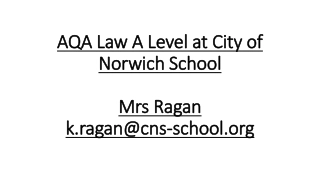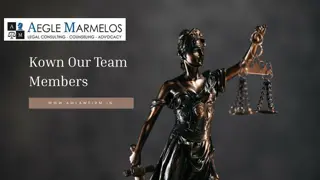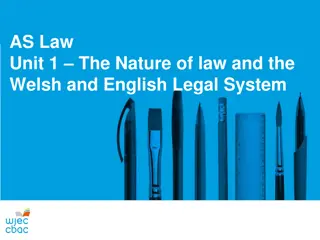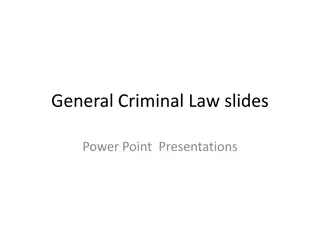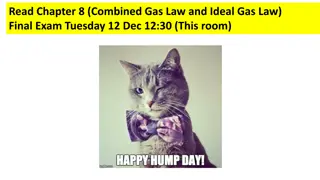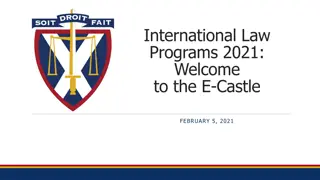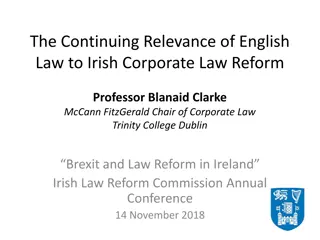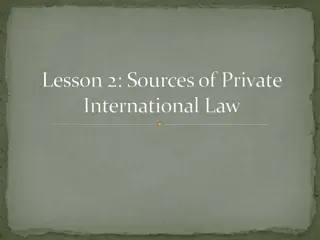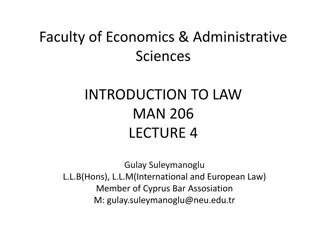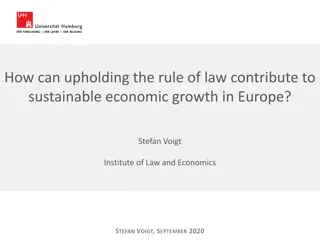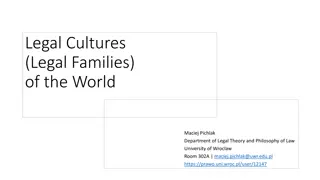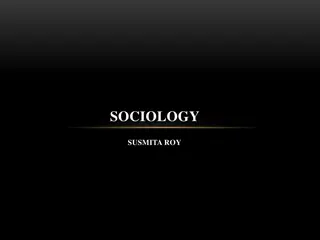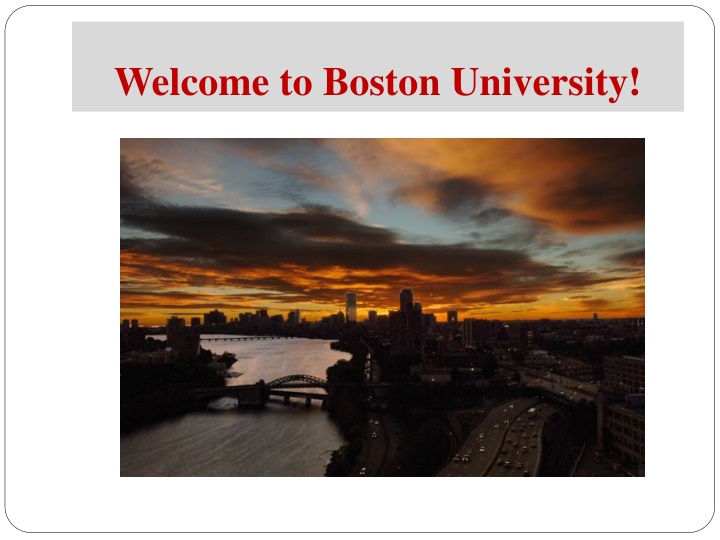
Exploring Topics in U.S. Law Through Boston University Course Syllabus
Delve into various aspects of U.S. law through a detailed course syllabus from Boston University. Topics include freedom of speech, freedom of press, freedom of religion, rights against unlawful search and seizure, right to privacy, gender discrimination, and prisoners' rights. Gain insights into the establishment and free exercise clauses in relation to freedom of religion, as well as the significance of religion in society according to Barker et al. Understand the interplay between the clauses in scenarios such as prayer in public schools. Access course materials and resources through Blackboard for further study.
Download Presentation

Please find below an Image/Link to download the presentation.
The content on the website is provided AS IS for your information and personal use only. It may not be sold, licensed, or shared on other websites without obtaining consent from the author. If you encounter any issues during the download, it is possible that the publisher has removed the file from their server.
You are allowed to download the files provided on this website for personal or commercial use, subject to the condition that they are used lawfully. All files are the property of their respective owners.
The content on the website is provided AS IS for your information and personal use only. It may not be sold, licensed, or shared on other websites without obtaining consent from the author.
E N D
Presentation Transcript
Topics in U.S. Law Ian C. Pilarczyk, B.A. (McGill); J.D. (Boston Univ.); LL.M. (McGill); D.C.L. (McGill)
Course Syllabus Class I (1/16/15): Intro/ Freedom of Speech: Symbolic Expression Class II (1/30/15): Freedom of Press Class III (2/13/15): Freedom of Religion Class IV (2/27/15): Rights Against Unlawful Search and Seizure Class V (3/6/15): Right to Privacy Class VI (3/27/15): Gender Discrimination Class VII (4/10/15): Prisoners Rights
Course Materials Course Materials All materials are found on the BlackBoard site for this course, found at: Learn.bu.edu LAW LE656 A1 Topics in American Law (Spring 2015)
Lecture III: Freedom of Religion: Establishment & Free Exercise Clauses Barker et al, Civil Liberties and the Constitution, 203- 209 & 213-218 (Establishment Clause) Everson v. Board of Education, 330 U.S. 1 (1947) Engel et al v. Vitale et al, 370 U.S. 421 (1962) Van Orden v. Perry, 545 U.S. 677 (2005) Barker et al, Civil Liberties and the Constitution, 261- 263 & 282-283 (Free Exercise Clause) Wisconsin v. Yoder, 406 U.S. 205 (1972) Welsh v. U.S., 308 U.S. 333 (1970)
Barker et al, Civil Liberties & the Constitution Religion is deeply important and central to many. Barker says that religion also can make people and the world better, but is also a source of wars, sectarianism, repression, and the like . Of course, religion is neither moral nor immoral, nor really a source of anything it simply inspires people to act for good or evil. Barker is right, however, when he says that it is central to most societies. Importance of the issue of religion to the framers can be seen in its central location in the Bill of Rights.
Barker et al, Civil Liberties & the Constitution Similarly to the language we saw around freedom of expression, the 1stAmendment says: Congress shall make no law respecting an establishment of religion (aka, the establishment clause ), or prohibiting the free exercise thereof. (the free exercise clause ) Are these clauses meant to work together? Does upholding one automatically violate the other? Does violating one automatically mean violating the other? Barker gives the example of prayer in public schools: if we prohibit it, does this violate free exercise clause? If we allow it, does this violate establishment clause?
Barker et al, Civil Liberties & the Constitution A central theme in European history was struggle over religion. This was no different in England, which during the reign of Henry VIII (and after) saw struggles for power/ rights between Catholics and Protestants, and conflicts between sects of Protestants. In the time of the framers, the Church of England was official church of the State, and King was the head of the Church. While many settlers from England arrived in the colonies to escape religious persecution, they often did the same to others.
Barker et al, Civil Liberties & the Constitution Many of the colonies had official churches, and different colonies had different official churches. The framers seemed to view this as a purely state issue, and the 1st Amendment was designed to prevent the federal government from following England s example and establishing an official national religion . It is clear that among the framers who did not want an official religion they had different reasons for doing so: some worried the state would corrupt the church; others that the church would corrupt the state; others that diversity of religion would be a good for society.
Barker et al, Civil Liberties & the Constitution So framers intent is of little help for constitutional analysis we have little documentary evidence, and what we do have makes clear there was no strong consensus of opinion as to the reasons for what we call separation of church and state . As Barker notes, there has been no real attempt to ever establish a national religion. So, what is the constitutional debate over?
Barker et al, Civil Liberties & the Constitution The debate is over when government action, or inaction, violates either clause of the 1st Amendment. Most fundamentally, is government to have no role in religion? Or to be a neutral observer? Or to ensure neutrality between religions? The jurisprudence related to this is confusing and, in some ways, confused. Here are the 3 main schools of constitutional thought: (a) the wall of separation between church and state government should have no dealings with religion. Problems with this?
Barker et al, Civil Liberties & the Constitution (b) government should be neutral and neither encourage or discourage religion. Problems with this? (c) government should accommodate religion that is, make space for it and not impose restrictions and burdens. Problems with this? As Barker points out, much of the jurisprudence centers around education and schools many schools historically were religiously-run ( parochial ) and even public schools used to have religious content. Tnsion between encouraging the education of the poor and not allowing state-sponsored religion.
Everson v. Board of Education, 330 U.S. 1 (1947) The is busing kids to religious schools ok? case
Everson v. Board of Education, 330 U.S. 1 (1947) FACTS: In 1941, New Jersey passed a statute that authorized school districts to finance and administer the transportation of pupils to and from schools, including to parochial schools, and reimbursed parents for the costs of sending their children to schools via public buses. 96% of the parochial schools were Catholic schools. A taxpayer challenged the district s right to reimburse parents of parochial school students, on state and federal constitutional grounds.
Everson v. Board of Education, 330 U.S. 1 (1947) PROCEDURAL HISTORY: The trial court held that the legislature was not empowered to authorize such payments under the state constitution. The N.J. Court of Errors and Appeals reversed, stating there was no state or federal constitutional issue. Supreme Court granted cert. ISSUE: Did the state statute violate the Establishment Clause of the 1st Amendment, as made applicable to the states through the 14th Amendment?
Everson v. Board of Education, 330 U.S. 1 (1947) HOLDING: No. The Establishment Clause is binding on the states via the 14th Amendment, but the state law does not violate the Constitution. RULING: The statute is challenged as being a law that establishes religion. We interpret the Establishment Clause in the sense that, as Thomas Jefferson said, it was intended to create a wall of Separation between church and State. New Jersey cannot use taxpayer funds to support any church or religious school, not can it interfere with
Everson v. Board of Education, 330 U.S. 1 (1947) their rights to practice their religion (or not) as they wish. Here, the state uses taxpayer funds to pay the fares of children attending school. While it is true that some children are therefore helped in studying at parochial schools, it is also true that the state does provide services to all students, regardless of the type of schools. For example, it provides policemen and traffic crossing guards, and provides utilities, services and infrastructure. The purpose of the 1st Amendment is not to deprive
Everson v. Board of Education, 330 U.S. 1 (1947) parochial schools of these services. The 1st Amendment requires the state to be a neutral in its relations with groups of religious believers and non-believers: it does not require the state to be their adversary . The state does not financially support the schools, it merely provides a general program that helps parents get their children to schools, regardless of whether they are religious schools or not.
Everson v. Board of Education, 330 U.S. 1 (1947) The First Amendment has erected a well between church and state. That wall must be kept high and impregnable. We could not approve the slightest breach. New Jersey has not breached it here. Dissent, Justice Jackson and Frankfurter: The opinion advocates complete and uncompromising separation of Church from State but seem(s) utterly discordant with its conclusion . District provides no services, it only reimburses for
Everson v. Board of Education, 330 U.S. 1 (1947) use of public buses. But the Act prohibits reimbursement for private schools operated in whole or in part for profit. Some children are sent to private schools because they need services since they are backward or defective and need special attention. This is not impartial, but designed to aid the public and parochial schools. To give tax aid to a church school is the same as giving tax aid to the church itself.
Everson v. Board of Education, 330 U.S. 1 (1947) Dissent, Justice Rudledge, Frankfurter, Jackson and Burton: The money used are tax funds. The Court does not deny that this money encourages and aids religious instruction but says this is not support under the law. This aid helps parents send their children to schools and aids them in a substantial way to get the very thing which they are sent to the particular school to secure, namely, religious training and teaching.
Everson v. Board of Education, 330 U.S. 1 (1947) Do the dissenters and majority have anything in common? In other words, is there some constitutional or other principle with which they all agree?
Everson v. Board of Education, 330 U.S. 1 (1947) LEGACY: While a 5-4 opinion with strong dissents, this was the first Court case to extend the Establishment Clause to the states, as prior to this it applied only to the federal government (there was a previous case, Cantwell v. Connecticut in 1940 that extended the Free Exercise Clause to the states). While the majority and minority disagreed whether the state was in fact supporting religion, they both agreed with the importance of a sharp separation between government and religion.
Everson v. Board of Education, 330 U.S. 1 (1947) Examples of cases that followed: McCollum v. Champaign Board of Education, 333 U.S. 2013 (1948) (voluntary religious classes conducted by public schools on school grounds are unconstitutional) Zorach v. Clauson, 343 U.S. 306 (1952) ( release time voluntary religious classes conducted off school grounds and not publicly funded are constitutional)
Engel v. Vitale, 370 U.S. 421 (1962) The no official prayer in public schools case
Engel v. Vitale, 370 U.S. 421 (1962) FACTS: The Board of Regents in NY created a voluntary prayer to start the school day for public schools, which read: Almighty God, we acknowledge our dependence upon Thee, and we beg Thy blessings upon us, our parents, our teachers and our country. Amen. The prayer was designed to be denominationally neutral , and students were allowed to remain silent or leave the classroom during its recitation. Plaintiffs, which included a group of parents, argued this was unconstitutional.
Engel v. Vitale, 370 U.S. 421 (1962) ISSUE: Does the reading of a nondenominational prayer at the start of the school day in public schools violate the Establishment Clause? HOLDING: You bet! Neither the non- denominational nor the voluntary character of this prayer saves it from violating the Establishment Clause. By creating and recommending this prayer, NY was officially approving and supporting religion.
Engel v. Vitale, 370 U.S. 421 (1962) RULING: In a 6-1 ruling (2 justices not taking part) the Court ruled that it is unconstitutional for state officials to compose an official school prayer and encourage its recitation in public schools. No doubt that this is a religious activity. It is conceded as such by all parties. This breaches the constitutional wall of separation between Church and State because Establishment Clause must at least mean it is no part of the business of government to compose official prayers.
Engel v. Vitale, 370 U.S. 421 (1962) Many early colonists fled this type of government- imposed official religion and common prayer in the U.K. It is unfortunate that these same groups often made theirs the official religion of the colonies. When the Constitution was adopted, the dangers and issues associated with official churches and religion was well known and they enshrined in it a zero tolerance for government interference with religious freedom.
Engel v. Vitale, 370 U.S. 421 (1962) NY state argues that the prayer is voluntary and non-denominational, but the mere promotion of religion is by itself a violation of the Establishment Clause regardless of whether it is coercive. The fact that the prayer is brief and general is also not a defense. To quote James Madison, It is proper to take alarm at the first experiment on our liberties.... It still promotes a family of religions (those that recognize Almighty God ).
Engel v. Vitale, 370 U.S. 421 (1962) Dissent, Justice Stewart: NY States did not interfere with free exercise of religion. And I cannot see how an official religion is established by letting those who want to say a prayer say it. On the contrary, I think that to deny the wish of these school children to join in reciting this prayer is to deny them the opportunity of sharing in the spiritual heritage of our Nation. wall of separation does not appear anywhere in the Constitution. The Court, Congress, the oath of
Engel v. Vitale, 370 U.S. 421 (1962) office of the President, all invoke God and involve prayer. The Star Spangled Banner contains In God We Trust ; the Pledge of Allegiance to the Flag contains reference to one Nation under God ; In God We Trust appears on our currency. To cite an earlier case, We are a religious people whose institutions presuppose a Supreme Being. (Zorach v. Clauson, 343 U.S. 306 (1952). Congress, this Court, the President, etc. have not established an official religion, nor do I think has NY state.
Engel v. Vitale, 370 U.S. 421 (1962) LEGACY: Engel is a landmark case that is the basis for a number of Court cases that have limited school prayer or related activities based on the Establishment Clause. For example, Wallace v. Jaffree (1985) (state law permitting one minute for prayer/meditation unconstitutional); Lee v. Weisman (1992) (no clergy-led prayer at middle school graduations); Santa Fe ISD v. Doe (2000) (no school-organized student-led prayer at high school football games).
Van Orden v. Perry, 545 U.S. 677 (2005) The religious monument near state house case
Van Orden v. Perry, 545 U.S. 677 (2005) FACTS: In 1961 a civic organization donated to Texas a monument that included the text of the Ten Commandments. It was placed near the state house, on a large area of parkland, that also contained 21 other monuments and 17 historical markers related to the history of Texas. It was challenged by a local lawyer; the district court found for the state; and this was affirmed by the Court of Appeals which state the monuments had a secular as well as religious purpose.
Van Orden v. Perry, 545 U.S. 677 (2005) ISSUE: Does a Ten Commandments monument on the grounds of the state capitol violate the Establishment Clause? HOLDING: No. The monument is part of our nation s tradition of recognizing the Ten Commandment s historical legacy. Simply having religious content, or promoting a message consistent with religion, does not violate the Constitution.
Van Orden v. Perry, 545 U.S. 677 (2005) RULING: The Court, in a 5-4 ruling, issued a plurality opinion upholding the constitutionality of the display. The Court acknowledged case law points in two directions: on the one hand, recognizing the importance of religious traditions throughout our history, and on the other, the belief that governmental intervention in religious matters can itself endanger religious freedom. We must maintain division between church and state while not being hostile to religion by preventing government from recognizing our religious heritage.
Van Orden v. Perry, 545 U.S. 677 (2005) Court mentioned the statutes and depictions of the Ten Commandments in its own building as well as throughout the Capital, and other examples that reflect their role in our nation s history and culture. The Ten Commandments are clearly religious, and as such the monument has religious significance. But Moses was a lawgiver as well as a religious leader. Simply having religious content or promoting a message consistent with a religious
Van Orden v. Perry, 545 U.S. 677 (2005) doctrine does not run afoul of the Establishment Clause. This is a passive display. The monument here has 2 purposes, related to both religion and government, and as such does not violate the Establishment Clause. Concurring, Justice Breyer: This is a borderline case. We must look at the context, which includes: numerous other monuments; its 40 year history without controversy; no sacred setting; monument part of a larger depiction of the state s ideals, etc.
Van Orden v. Perry, 545 U.S. 677 (2005) Dissent, Justice Stevens: The monument suggests that Texas specifically endorses the Judeo- Christian values set out in the Ten Commandments and therefore violates the Establishment Clause.
Barker et al, Civil Liberties & the Constitution Similarly to how constitutional protections are not needed for mainstream speech, it has often been the case that cases involving religion have concerned non-mainstream groups. Cantwell v. Connecticut, 310 U.S. 296 (1940) extended the Free Exercise Clause to the states. Other cases disallowed license fees for selling religious merchandise, holding that the power to tax the exercise of a privilege is the power to control or suppress its enjoyment.
Barker et al, Civil Liberties & the Constitution Other cases, related to the requirement that businesses be closed on Sundays, ruled that if a state passed a law that is within the scope of its power, and which is designed to advance a secular goal, it will not be unconstitutional by virtue of having an indirect negative effect on religion unless the government has a less intrusive means of accomplishing the purpose. A more stringent burden was later established in Sherbert v. Verner (1963), which said the State
Barker et al, Civil Liberties & the Constitution must have a compelling state interest in regulating something that they had the power to regulate, and that they had no other alternative method that would not infringe 1st Amendment rights (i.e, strict scrutiny standard). One of the most contentious areas has been around compulsory military service. Does this infringe on religious liberty when religion requires people to be pacifists, or if they feel a war is unjust? We will discuss this issue in the context of the Welsh case.
Wisconsin v. Yoder, 406 U.S. 205 (1972) The must Amish go to school? case
Wisconsin v. Yoder, 406 U.S. 205 (1972) FACTS: Three Amish families were prosecuted under a state law that required all children to attend public school until 16. In Amish tradition, many children stop attending school after 8th grade. Amish religion put an emphasis on simple living and it was thought that further education was unnecessary and would even endanger their salvation. ISSUE: Did this law, criminalizing the refusal of parents to send their children to school for religious reasons, violate the Free Exercise Clause?
Wisconsin v. Yoder, 406 U.S. 205 (1972) HOLDING: Yes. The Wisconsin Compulsory School Attendance Law violates the Free Exercise Clause because compulsory school attendance past 8thgrade interfered with parents rights to direct the religious upbringing of their children. RULING: In a 7-0 decision (Douglas filed a partial dissent but voted with majority), the Court ruled that such laws were a violation of religious freedom. The traditional way of life for the Amish is deeply- rooted in religion. They live in a church-oriented
Wisconsin v. Yoder, 406 U.S. 205 (1972) community, separated from the outside world, free from outside influences and technology and based on an agrarian lifestyle. Compulsory education laws were not harmful to their way of life as long as it was conducted nearby in a rural school house with a large proportion of Amish children. But high schools, often consolidated and at a distance, adversely affected Amish children in their community integration. The law compels them to perform acts at odds with
Wisconsin v. Yoder, 406 U.S. 205 (1972) their faith, and threatens their way of life. It puts the parents in an impossible situation--breaking the law and being prosecuted, moving, or following a law that undermines their communities. The state was unable to provide any real evidence that a further 2 years of education in public schools would greatly benefit Amish children. Their communities are tight-knit, civically minded, reject all forms of social welfare, and education is continued in the form of vocational training.
Wisconsin v. Yoder, 406 U.S. 205 (1972) There was also no evidence that Amish children, without the additional 2 years of education, would become burdens on society. Their 200+ years of tradition also demonstrated their communities have been very successful in maintaining their traditions in the face of mainstream contemporary society. There is no sign of adverse effects on their children due to attending school only to the age of 16. With respect to Justice Douglas dissent, it is not the children s rights with which we are concerned
Wisconsin v. Yoder, 406 U.S. 205 (1972) here as it is the parents who are liable to prosecution. Dissent (in part), Justice Douglas: I agree that the Amish have issues with public education past 8th grade, but I do not agree this is merely an issue that concerns the parents. Since it most directly impacts the children, they should be heard these decisions might have an effect on their dreams to be scientists, etc. His entire life may be stunted and deformed if his education is shortened.

